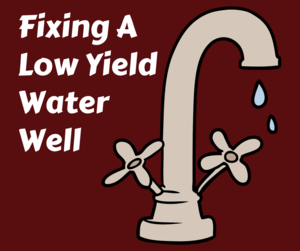CALL TODAY 1-800-441-6281
CALL TODAY 1-800-441-6281

Cleaning a Residential Water Well
Water safety organizations, including the National Ground Water Association, encourage homeowners to periodically get a water well system check-up. This check-up will help you determine whether your well needs cleaning.
What Is Well Cleaning?
Much like a public water system, chemicals can be added to a private water well to kill bacteria, if found in the water. However, there are also chemicals that can be added to loosen debris, allowing it to be pumped out of the well. This can be a good option for wells where the casing is in poor condition or has been corroded over time.
Homeowners can also clean a private water well mechanically. At the Essex House on the PBS repair show This Old House, Roger Skillings, owner of Skillings & Sons, opts to clean this older and slow-flowing well mechanically by running a drill into the well to loosen and remove debris.
Skillings was called in to the Essex House after construction crews thought they had run the well dry while trying to fill a small pond on the property. When Skillings and his crew pulled the water pump from the well, they discovered substantial rust encrustation on the pipes both inside and out, indicating there was a high amount of iron in the water.
Skillings recommended sending a drill bit down into the well to clean it of rust and other debris, while also determining the actual depth of the well and the well’s flow rate – or how much water it is capable of producing. After redrillingand cleaning the well, the flow rate went from 3 gallons a minute to 30 gallons a minute.
HOW DO I KNOW IF MY WELL NEEDS CLEANING?
- Well water that is cloudy when it comes from the faucet or from a hose is known as turbid. Water with high turbidity indicates suspended materials in it, such as decayed organic matter or silt.
- Reduced well capacity, or the amount of water a well pump can supply the home per minute.
- Your well water has developed a new funny taste or odor.
- The cause of these problems could be bacteria. Near the water line at the top of the well, oxygen and water interact, creating a favorable environment for the growth of bacteria. This can create a number of well-clogging problems, from forming slime to oxidizing iron and manganese.
This debris eventually migrates from the top of the well to the bottom. There chemical reactions and bacterial activity can cause problems with a different kind of bacteria, anaerobic bacteria, which live in environments devoid of oxygen. These are naturally occurring bacteria often found in aquifers, but they can cause methane gas, unpleasant tastes and various odors, including the rotten egg smell that comes with hydrogen sulfide contamination.
These problems can also be caused by encrustation. This is a coating that forms where the water flows into the well casing or within the well casing that slows the flow of water from the well into the home.
Whether it’s bacteria or encrusted pipes, neglecting these issues can cause your well pump to run more often, putting more strain on the system and costing you more in electricity.
Contact a certified well water system specialist, like Skillings & Sons. They can help determine whether your well needs cleaning and your options for fixing the problem quickly with their rolling warehouse fleet of trucks.

